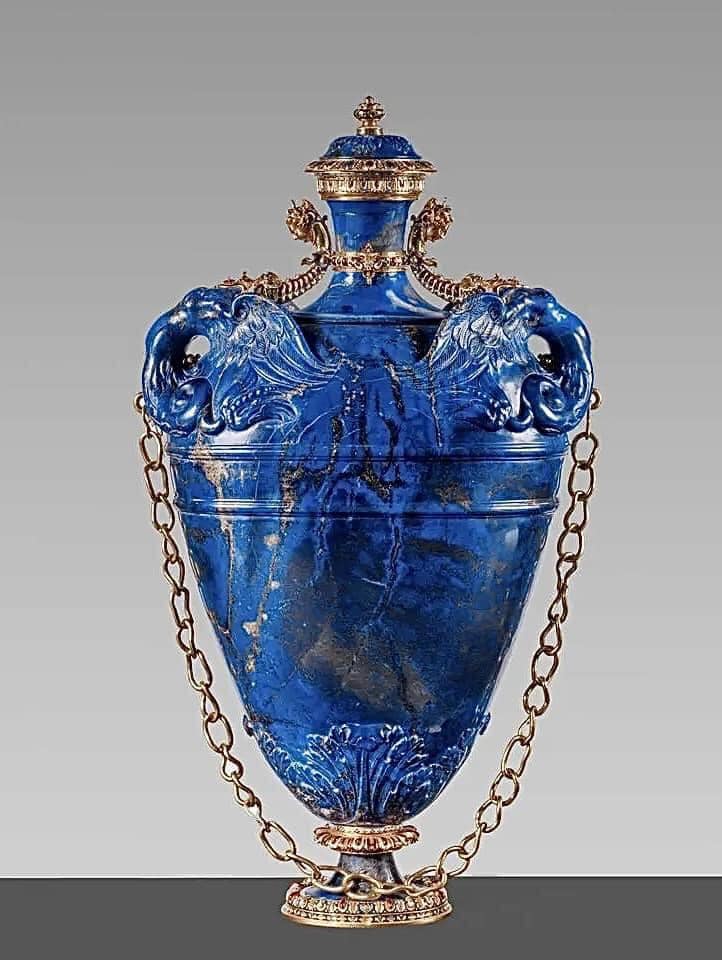In the twilight of the 16th century, as the Renaissance reached its zenith, an extraordinary masterpiece emerged in the heart of Florence. This creation was no ordinary object but a flask so remarkable that it would later be known as “Blue Magic.” It was not only a testament to artistic skill but also a symbol of the era’s innovation, reflecting the fusion of stone, gold, and human ingenuity. The creation of “Blue Magic” began between 1583 and 1584 within the bustling Grand-ducal workshop of Florence.

Under the guidance of Bernardo Buontalenti, a renowned architect celebrated for his inventive spirit, a team of highly skilled artisans set to work on a singular, ambitious project. Their chosen canvas was a massive block of lapis lazuli, a deep blue semi-precious stone that had been prized since antiquity for its vibrant color and rarity. This block, standing an impressive sixteen inches tall, was carefully selected to become the foundation of the flask that would later captivate generations. Guided by Buontalenti’s preliminary sketches, an anonymous sculptor began the delicate process of carving the lapis lazuli. With each precise strike of the chisel, the stone began to reveal its inner beauty, transforming into a form that was both bold and expressive.
The sculptor’s skill was evident in every curve and contour, as the raw stone took on a fluid elegance that seemed to defy its solid nature. Yet, the transformation was only beginning. To elevate the flask from a finely carved object to a work of true artistic genius, Jacques Bijlivert, a celebrated Flemish goldsmith, was brought into the project. Bijlivert’s mastery of metalwork would prove essential in creating the flask’s defining details, which would distinguish “Blue Magic” from any other object of its kind. Bijlivert’s contribution was nothing short of spectacular. Using techniques refined through years of practice, he crafted gold and enamel fittings designed to complement the lapis lazuli’s rich blue hue.
The gold gleamed with a warm brilliance, contrasting beautifully with the cool depths of the stone, while the enamel added vibrant splashes of color that enhanced the flask’s visual appeal. Every element of the design was executed with meticulous care, from the delicate gold filigree to the precisely shaped enamel inlays, showcasing a level of craftsmanship that epitomized the artistic achievements of the Renaissance. The flask was not merely a decorative object; it embodied the artistic and cultural aspirations of its time. The Medici family, one of the most powerful and influential families in Renaissance Italy, were known for their passionate patronage of the arts. Through their support, Florence became a center of artistic innovation, attracting talented artists and craftsmen from across Europe. “Blue Magic” was a testament to this legacy, representing the Medici’s desire to push the boundaries of creativity and craftsmanship. In this single piece, the realms of art and function merged seamlessly, creating an object that was both visually stunning and deeply symbolic. Even as centuries have passed since its creation, “Blue Magic” continues to captivate all who encounter it. Its enduring appeal lies not only in its aesthetic beauty but also in the story it represents—a story of artistic collaboration, technical mastery, and the human drive to create something extraordinary.
The flask serves as a bridge between the past and present, inviting modern audiences to marvel at the achievements of Renaissance artisans and to appreciate the timeless allure of their work. As we gaze upon “Blue Magic,” we are reminded that it is more than just a flask; it is a convergence of art, culture, and history. Each element of its design reflects the spirit of an age defined by its quest for beauty and knowledge, while the harmonious combination of stone and metal speaks to the limitless possibilities of human creativity. The flask’s journey from a raw block of stone to a masterpiece of Renaissance craftsmanship serves as a testament to the transformative power of art, demonstrating how the vision and skill of a few individuals can create something that continues to inspire and amaze centuries later. In a world that often moves at a relentless pace, “Blue Magic” stands as an invitation to pause and appreciate the wonders that human hands can create. Its flawless proportions, intricate details, and vibrant colors speak to a time when artistry was valued not only for its aesthetic appeal but also for its ability to elevate the human spirit. Through this remarkable object, we are reminded of the extraordinary heights that can be reached when creativity and craftsmanship come together in perfect harmony.
Even today, “Blue Magic” remains one of the most admired treasury objects ever created. Its presence in museums and private collections serves as a testament to its enduring significance, offering a glimpse into a world where art was not merely a profession but a calling. For those fortunate enough to see it in person, the flask’s beauty is a reminder of the Renaissance’s lasting impact on the world of art and design, a legacy that continues to shape our understanding of what is possible when human imagination is given free rein. Ultimately, “Blue Magic” is more than just an object—it is a symbol of the human desire to create, innovate, and leave a lasting mark on the world. Its story is one of collaboration and craftsmanship, of artists and artisans coming together to push the boundaries of their craft. As we reflect on its journey from a block of lapis lazuli to a masterpiece of Renaissance art, we are reminded that the true magic lies not only in the object itself but in the passion, skill, and creativity that brought it to life. Through “Blue Magic,” we are invited to see the world through the eyes of those who dared to dream of something extraordinary, and in doing so, we discover that the magic of the Renaissance still has the power to inspire us today.





